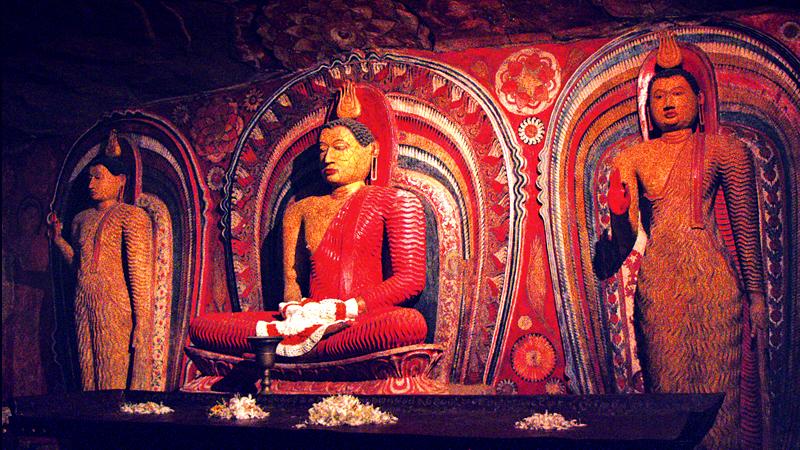
The much-famed Degaldoruwa Raja Maha Vihara accommodated in a cave containing well preserved Kandyan paintings is situated in the village of Degaldoruwa. It is half a kilometre along the Yakgahavita road which commences at the Sirimalwatta ambalama on the Kandy – Lewella road. The Vihara can be seen on the left of the road.
We reached the Degaldoruwa vihara at 10 in the morning following the tumultuous journey on the narrow roads in the outskirts of Levelle in the Dumbara valley in a three-wheeler that we had hired in Kandy 20 minutes ago.
 The noise of the three-wheeler engine bounced back at us from the walls of the shuttered houses on either side of the road. Turning to a sandy road, at the end of it we saw the outline of a white building in the morning sunlight, with arched-doors and a tall belfry standing alongside the building – the entrance to one of Sri Lanka’s finest examples of Kandyan murals, the Degaldoruwa Temple.
The noise of the three-wheeler engine bounced back at us from the walls of the shuttered houses on either side of the road. Turning to a sandy road, at the end of it we saw the outline of a white building in the morning sunlight, with arched-doors and a tall belfry standing alongside the building – the entrance to one of Sri Lanka’s finest examples of Kandyan murals, the Degaldoruwa Temple.
We removed our shoes and put them in the back of the three-wheeler and entered the temple compound and saw the white-washed structure through the foliage in the hillock. Waiting a few minutes in the office room, I met the Viharadhipathi and got permission to take photographs without using the flash directly on the murals.
Cave
This cave is an enlargement of a small cave that was found in the western slope of a rock 12.31 metres (40 ft) in height. King Kirthi Sri Rajasingha while constructing the Vihara at Galmaduwa had lived in this cave and devoted his attention to improve it.
According to a reference in the Degaldoruwa Sannasa the placing of the eyes on the statues had been done in 1761. King Rajadhi Rajasingha, brother of Kirthi Sri Rajasingha who was a prince at that time was instrumental in this construction. Details of the construction are discussed in the Sannasa.
The Degaldoruwa vihara has been built into the base of a rock cave, which is cut into two chambers. The first is a drumming hall built with wooden columns, and a colourful Makara Thorana, (dragon arch) intricately carved out of wood stands at the entrance to the cave.

This has been a later addition by Migastenne Adikaram. In the cave is a large recumbent Buddha statue with two standing and seated Buddha statues on either side.
The ceiling of the rock and walls contain some fine pictorial compositions in the story of Sinhala art.
The murals at Degaldoruwa vihara are considered some of the finest examples of art belonging to the Kandyan kingdom. Religion is the theme of Kandyan murals and the method adopted is continuous narration of the subject for the education of the people. The murals date back to the 18th Century.
Jathaka stories
Jathaka stories such Satthubhatta, Sutasoma, Seelawa and Vessanthara painted on the outer wall are among the best examples preserved in the Vihara. Of them scenes from the Vessanthara Jathaka are considered as the most outstanding creations.
The biggest and probably the most interesting mural in the rock ceiling is the one depicting the Maara Yuddaya (demons in battle).
The most striking features in this painting are the Maaraya with five faces leading the battle with elephants and the Maara warriors with guns and arrows in their hands.
Also impressive is the beautiful figure of the Polomahikanthawa (earth woman) holding a painted pot just below the painting of the Buddha.
There is a large Buddha image in the Vihara. But the shrine has gained prominence due to numerous paintings of the Kandyan period which include the suppression of Maara. Devaragampola Silvat, a bhikkhu who is a renowned artist of the Kandyan period was responsible for the paintings.
Sharp lines have been drawn to obtain the contours in the paintings drawn in a predominately red background.
Today, some paintings on the ceiling and walls of the main chamber are dilapidated and ruined.
Some have faded. However, a section of the ceiling murals seem to be well protected by the Department of Archaeology.
The Degaldoruwa rock cave temple is testimony to yet another treasure trove of the Kandyan kingdom. The murals are however, in a sad state. There is a dire need for institutes such as the Archaeology Department to step in and conserve the remains before all is lost.
